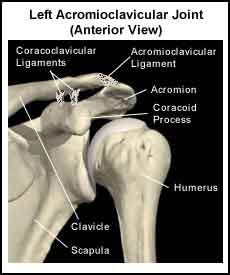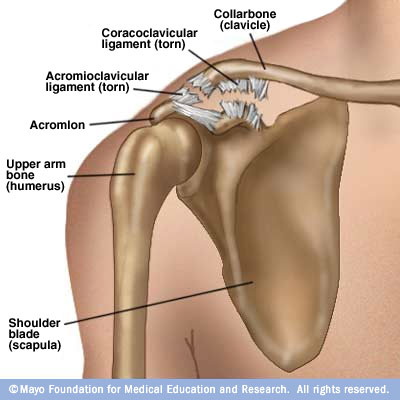Anthony Donskov
Anthony Donskov is the founder of DSC where he serves as the Director of Sport Performance. Donskov holds a Masters Degree in Exercise Science & is the author of Physical Preparation for Ice Hockey.
AC Joint Injuries in Hockey
- Font size: Larger Smaller
- Hits: 13150
- Subscribe to this entry
- Bookmark
Hockey is a high impact, high intensity, physically demanding sport. At the highest level of play, the game moves at amazing speeds. Scott Niedermayer won the 1998 “fastest skater” in the NHL Skills competition by circling the rink in 13.56 seconds, which translates to about 28 mph. Can you imagine absorbing the impact of a car traveling at this speed, yet alone two cars colliding at similar speeds? Welcome to the great sport of hockey!
The majority of shoulder injuries in the sport are due to high impact traumatic events. The mechanism of AC joint injury is a direct fall/impact to the lateral aspect of the shoulder (1). This happens frequently during the “organized chaos” of a hockey game. Shoulder injuries remain the most common site of injury in the sport of hockey (in youth populations) (2).
The Acromioclavicular Joint
The AC joint is an inherently unstable joint. It consists of articulation between the acromion and the clavicle. The acromioclavicular ligament, and the coracoclavicular ligament (splits into the conoid and trapezoid) reinforce the joint and provide horizontal and vertical stability respectively; two muscles, the deltoid and the trapezius also provide stability. High impact forces can cause separation and damage to these ligamentous structures.

AC Joint Pathology
Injury to the AC joint is classified according to the amount of damage by the direct force applied. There are currently six classifications.
- Type I: Sprain of the AC ligament
- Type II: AC joint disrupted with tearing of the AC ligament, coracoclavicular ligament sprained.
- Type III: AC ligament disrupted, AC joint displaced, coracoclavicular ligament disrupted, deltoid and trapezius usually detach from distal end of clavicle.
- Type IV: AC ligaments disrupted, AC joint displaced, clavicle anatomically displaced through trapezius muscle, coracoclavicular ligament disrupted, deltoid and trapezius detached.
- Type V: AC and coracoclavicular ligaments disrupted, AC joint dislocated, gross displacement between clavicle and scapula.
- Type VI: AC and coracoclavicular ligaments disrupted, distal clavicle inferior to acromion or corocoid process, deltoid and trapezius detached from clavicle.
(Courtesy of The Athlete’s Shoulder)

Photo courtesy of Mayo Foundation
Strength and Conditioning Ramifications
Typically injuries seen in hockey fall between the Type I and Type II category, where conservative treatment is recommended. Depending on the pathology, 7-10 days (or more) of rest, followed by a gradual rehabilitation program is recommended. After completion of this program, an adequate strength and conditioning program is necessary. It’s important to have an open forum of communication between the therapist and coach. Many times the athlete may have:
- Tenderness/pain with direct palpation
- Pain at end range of motion (horizontal abduction/traction/approximation)
Our approach at Donskov Strength and Conditioning is to NEVER push through pain. However, if we can work around it to promote an expedited healing process, we’re all about it. Several of the exercises used in our “tool box” include:
- Horizontal Pulling: strengthen the scapular retractors/depressors to open up the sub-acromial space.
- Lower Trapezius/Serratus work: Isolated work to control scapular depression and upward rotation.
- Yoke Bar: Eliminates external rotation and allows us to perform RFESS, lunges, reverse lunges, ect.
- Floor Pressing: Limits horizontal abduction at end range.
- Board Pressing: Limits horizontal abduction at end range.
- DB Pressing: Allows us to control “bar path” with neutral grip.
- Multi-Purpose Bar: Keeps the shoulder in closed packed position while avoiding horizontal abduction.
Yoke Bar Reverse Lunge
DB Floor Press
Multi Purpose Bar
In addition to these exercises, we avoid:
- Dips
- Upright Rows (can you say Hawkins impingement test?)
- Cleans (due to direct pressure on clavicle)
- Front Squats (due to direct pressure on clavicle)
AC joint injuries are common in the sport of hockey. It’s important that once an athlete is ready to start a structured strength and conditioning program that he/she does not do more potential harm in the weight room. The coach controls safety and exercise protocol, if an athlete gets hurt or re-injured in the weight room, it’s the strength coaches’ fault. It’s also important the we asses our programs on a periodic basis to see how effective our protocol is in strengthening and preparing the athlete to return to sport. Understanding the demands of sport, injury trends and effective rehab protocol further separates good coaches from GREAT coaches!
References:
(1) Wilk, K, Reinold, M, Andrews, J, The Athlete’s Shoulder, Churchill Livingstone, 2009.
Anthony Donskov, MS, CSCS, PES, is a former collegiate and professional hockey player, founder of Donskov Strength and Conditioning Inc., (www.donskovsc.com) and Head Instructor/Director of Off-Ice Strength and Conditioning for Donskov Hockey Development (www.donskovhockey.com). He can be reached at info@donskovsc.com .
Facebook: http://www.facebook.com/pages/Donskov-Strength-and-Conditioning-Inc/111694352189187
Twitter: http://twitter.com/Donskovsc
